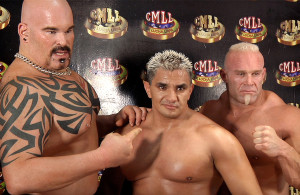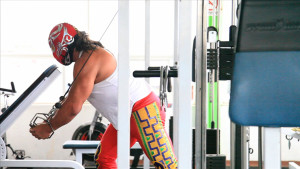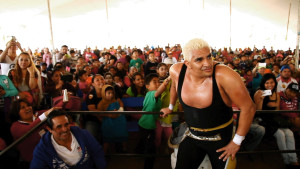After working together on the 2012 documentary Better Than Something: Jay Reatard, independent filmmakers Ian Markiewicz and Alexandria Hammond traveled south of the border to find their next larger-than-life subjects. The result is Lucha Mexico, a documentary about the colorful world of lucha libre, better known to us gringos as Mexican wrestling. After dedicating four years of their lives to this project, Lucha Mexico premiered at the Guanajuato Film Festival in July. The film’s United States premiere takes place this Friday, Nov. 13 (with an additional screening on Nov. 18) at DOC NYC with appearances by the filmmakers and “El 1000% Guapo” Shocker and Jon “Strongman” Andersen, stars of Mexico’s most prominent wrestling promotion Consejo Mundial de Lucha Libre.
“I’ve been a wrestling fan my whole life and I really wanted to make a wrestling film,” says Markiewicz. “I was interested in how guys go down to Mexico to build up their careers, rehab their careers or whatever it may be.”
“My mother’s from Mexico, so I spent my whole life going down there,” adds Hammond. “I actually wanted to make a doc on bullfighting and matadors and what they go through, why they do it. I decided I didn’t want to make a film about animals dying, then Ian presented lucha to me. It was immediately what I wanted to do. It’s insane that they put their bodies on the line for this entertainment. I became obsessed.”

International star Gigante Bernarnd (NXT’s Jason Albert, left), Shocker (middle) and Strongman (right) have interesting stories in “Lucha Mexico”.
This obsession is apparent in Lucha Mexico, which not only gives an informative overview of one of Mexico’s most popular forms of entertainment, but also follows the lives of particular wrestlers including Shocker, Strongman, the legendary Blue Demon Jr., CMLL mini mascot Kemonito, Gigante Bernard (now WWE NXT trainer Jason Albert), and Fabian “El Gitano” and El Hilo de Perro Aguayo, who both died during the course of the film.
“When we started shooting we didn’t have an agenda to find the specific things that are in the film,” says Markiewicz. “It was more that we were open to what the experience would be and just showing that. Over the course of that time, this story formed and these characters have different arcs along the way.”
Unlike American wrestling, which is largely seen as a farcical form of entertainment, Mexican wrestling fans still hold their heroes in high regard, which is apparent in Lucha Mexico. Even though the film shows in-ring rivals working out together (in their masks to maintain mystique) and interacting in nonviolent ways outside the ring, it respects the traditions of this athletic form of art.
“We wanted to be respectful of the fans and how the people see lucha,” says Hammond. “These are their superheroes. We got to see wrestlers without their masks, but we would never have shot them that way. But Blue Demon Jr., for instance, would never show anyone his face. He’s a truly-dedicated masked wrestler, and most of them are. We really wanted to honor and respect this cultural thing. We were excited to get so close to some of the most famous wrestlers in Mexico. It’s not about some beginner trying to make it. We’ve seen that story and it’s a great story, but we’re glad we got to share the world of these guys who have been in it for a while.”
“We wanted to make sure we were getting the world and getting the experience of being there,” adds Markiewicz. “A lot of these tangents and other details are building up the world around the characters you’re going to spend more time with in the film. We wanted you to feel not just them and their stories, but the environment and experiences of really being there with them. When you’re down in Mexico and you’re talking to one wrestler, he’s going to say, ‘You’ve got to meet my friend. He’s working at this other show.’ They’re all so connected and they bring you around to all these things. They were pushing the idea of it being this one big world on us a lot of the time because that’s just how they feel about it. It would have been inauthentic in a lot of ways if we hadn’t tried to fill all that in.”
In much the same way it shows the respect between in-ring combatants, the film also illustrates the odd camaraderie between rival promotions, including footage from the traditional CMLL, the younger Asistencia Asesoría y Administración and the hyper-violent Los Perros del Mal. The parallels between the current lucha climate and the American wrestling scene of the ’90s is unmistakable, but you’d never have seen the United States equivalents World Wrestling Federation, World Championship Wrestling and Extreme Championship Wrestling (all now owned by WWE) cooperating on a film being made by people from outside the business.

Los Perros del Mal’s El Hijo del Perro Aguayo appears in “Lucha Mexico” before making the ultimate sacrifice in the ring earlier this year.
“Los Perros del Mal is definitely similar to something like ECW and AAA is no doubt very similar to WCW in a lot of ways,” Markiewicz admits. “Their approach to it is different, but it’s amazing how many similarities there are. In Mexico there was always the sense of, ‘You’re making a film about lucha libre. We’re all part of lucha libre.’ You may not see wrestlers moving back and forth between companies, but there was never a sense of, ‘Oh, you went and worked with Perro Aguayo? We’re not going to talk to you.’ CMLL in Arena México is the biggest thing. It has the most history and has the building. They knew we were shooting with other wrestlers and other companies and they really didn’t try to stop us and didn’t seem to have a problem with it. Even when people have seen the film, they’re like, ‘That’s fine.'”
This sense of community and family pervades Lucha Mexico, and Mexican culture in general. Perhaps that’s what makes the lucha atmosphere so much different from what American wrestling fans are accustomed to. That certainly seems to be the case from what is seen in this film.
“It’s so colorful it’s overwhelming,” says Hammond. “That’s part of the reason we took such a long time. We could have made a simple film about one guy or one girl or one ref, but Ian and I both said, ‘There’s no way to say it all.’ That’s what makes it unique. There’s something super special about it because it’s an entertainment and sport that captures the whole family. In Mexico it’s all about family and bringing people together. That’s what makes it so different. It’s an escape and people need it. We really wanted to capture this incredible rich thing.”
LUCHA MEXICO (Teaser) from Children of Productions on Vimeo.



